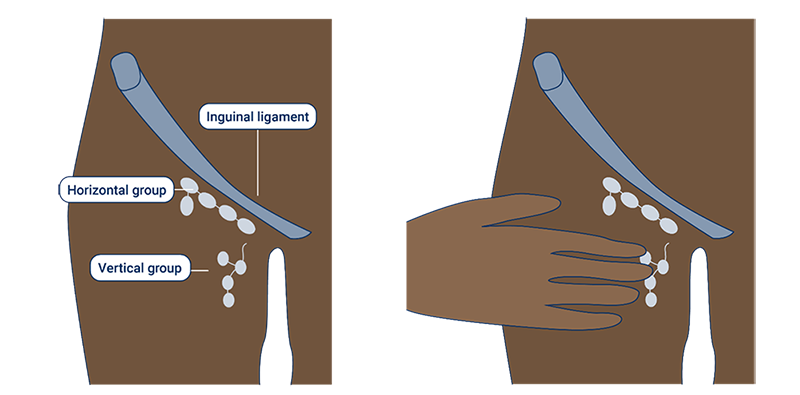
What are the aims of this leaflet?
This leaflet has been written to help you to understand more about checking your lymph nodes (‘glands’) yourself. It tells you what lymph nodes are, where to find them, why and how often you should check them. It also explains how to check lymph nodes. At the end of the leaflet there is further detail on where you can find out more information.
What are lymph nodes?
The Lymphatic System
The lymphatic system is part of the immune system and acts as a defence network. It protects the body from harmful substances and infections.
- Lymphatic vessels: These are thin tubes that carry a colourless fluid called lymph throughout the body. They collect lymph from tissues and drain it into larger vessels called ducts. These ducts are found in the neck and join the bloodstream near the heart (see Figure 1).
- Lymph: Lymph fluid contains water, nutrients, and immune cells called lymphocytes. nutrients and waste materials. Lymph bathes the cells of the skin and internal organs to nourish them. It also helps draining out waste materials.
- Lymph nodes: Lymph nodes (‘glands’) are small ‘bean-shaped’ nodules that contain millions of infection-fighting lymphocyte cells. Lymph nodes are found at intervals along the lymphatic vessels, like ‘beads on a string’. While lymphocytes destroy harmful organisms and abnormal cells, the lymph nodes filter them out before the lymph reaches the blood stream.

Figure 1. Lymph nodes throughout the body
Lymph nodes can only be felt in certain areas of the body (see Figure 1):
- head and neck
- axilla (armpit)
- inguinal area (groin)
- back of knees
Lymph nodes are usually too small to feel. However, in certain situations they can be easy to notice. For example:
- In people with less body fat, it may be easier to feel them as smooth, pea-sized lumps, especially in the groin. This happens because there is less fat tissue covering the lymph nodes in this area.
- Lymph nodes can be felt during infections. When the body is fighting an infection, the lymph nodes that are nearest to it may become enlarged, painful and tender. This is because they are helping to trap and destroy the germs and other microorganisms causing the infection. For example, a sore throat or an ear infection can make lymph nodes in the neck enlarged and painful.
- Lymph nodes can become enlarged if cancer cells lodge in them. In this case, the nodes are usually painless.
Why should you be checking your lymph nodes?
If you have been diagnosed with a skin cancer, it is important to check your lymph nodes regularly. Skin cancer (for example, melanoma or squamous cell carcinoma) can spread to other organs as well as the lymphatic system.
At your check-up visits, you will usually have the lymph nodes near the location of your skin cancer examined. For example, if the skin cancer is on your face, then the nodes around your ears and neck will be examined; if the skin cancer is on your leg, then the lymph nodes behind your knee and in your groin will be felt. The aim is to detect any enlargement of the lymph nodes at an early stage.
Some people are advised to check their lymph nodes between clinic appointments. If you are worried about enlarged lymph nodes, tell your healthcare professional straight away. Do not wait until your next clinic appointment.
If you are unsure about anything in this leaflet, please talk to your healthcare professional, who can show you how and which lymph nodes to check.
How often should I check my lymph nodes?
It is usually advised to check your lymph nodes once a month. This can be done at the same time as you check your skin for new or changing moles, lumps and bumps.
Do not be alarmed if you feel a lymph node (especially if it is tender) as it may be due to an infection, but if it has not reduced in size in a week, contact your doctor or clinical nurse specialist.
How to check lymph nodes in the head and neck?
The illustration below (Figure 2) shows the location of lymph nodes in the head and neck.
Use your fingertips in a gentle, circular motion to feel the lymph nodes in the areas illustrated. Examine in the order shown, starting from 1 to 10:

Figure 2. Location of lymph nodes (dark blue dots) around the jaw and neck
To feel nodes in the head:
- Start with pressing gently the nodes in front of your ear (number 1) and follow in the order finishing just above the collar bone (number 10).
- Always check your nodes in this order.
- Feel for lumps or swelling and check both sides for comparison.
- Swollen lymph nodes feel enlarged or firm and may be the size of a pea or grape

Figure 3. Checking the lymph nodes in front of the ear
To feel for nodes in your neck:
- Tilt your head towards the side you are examining, this helps to relax the muscle.
- Now gently press your fingers under the muscle.
- Repeat on the other side for comparison.

Figure 4. How to check lymph nodes in the neck
To check lymph nodes above the collar bone:
- Hunch your shoulders and bring your elbows forward to relax the skin.
- Press gently into the hollow above the collarbone.
- Use a circular motion over the lymph nodes in the area.

Figure 5. How to check lymph nodes above the collar bone
How to check lymph nodes in the armpit?
The illustration below (Figure 6) highlights where you can feel lymph nodes in the armpit.

Figure 6. Lymph nodes in the armpit Figure 7. How to check lymph nodes in the armpit
As with the nodes in the head and neck, follow the number order when examining your armpits.
Before checking your armpit lymph nodes, sit or stand comfortably and remove top clothing down to the waist to access the armpits. Check each armpit in turn.
- To check the left side, lift your arm slightly, then place the fingers of your right hand high into the armpit and then lower your arm (Figure 7).
- Gently press and move your fingers in a circular motion.
- Feel in the central area of the armpit
- Now move your fingers firmly against the chest wall as follows:
- Along the front border of the armpit
- Along the back border of the armpit
- Feel along the underside of the upper arm
Now check the other armpit in the same way.
How to check lymph nodes in the groin?
There are two areas to feel in the groin (see Figure 8):
- Horizontally along the groin crease
- Vertically along the upper thigh

Figure 8. Checking the lymph nodes in the groin
- Use your fingertips to press gently the crease between your upper thigh and lower abdomen.
- Feel for small round lumps under the skin.
- Check both sides.
Where can I get more information about checking lymph nodes?
Weblinks to other relevant sources:
https://lymphoma-action.org.uk/about-lymphoma-what-lymphoma/lymphatic-system
https://www.nhs.uk/conditions/swollen-glands/
https://patient.info/signs-symptoms/neck-lumps-and-bumps-leaflet/swollen-lymph-glands
Jargon Buster: www.skinhealthinfo.org.uk/support-resources/jargon-buster
Please note that the British Association of Dermatologists (BAD) provides web links to additional resources to help people access a range of information about their treatment or skin condition. The views expressed in these external resources may not be shared by the BAD or its members. The BAD has no control of and does not endorse the content of external links.
This leaflet aims to provide accurate information about the subject and is a consensus of the views held by representatives of the British Association of Dermatologists: individual patient circumstances may differ, which might alter both the advice and course of therapy given to you by your doctor.
This leaflet has been assessed for readability by the British Association of Dermatologists’ Patient Information Lay Review Panel
BRITISH ASSOCIATION OF DERMATOLOGISTS PATIENT INFORMATION LEAFLET
PRODUCED | AUGUST 2011
UPDATED | SEPTEMBER 2014, NOVEMBER 2017, NOVEMBER 2020, SEPTEMBER 2024
REVIEW DATE | SEPTEMBER 2027
Download a PDF of this page using the link below:
Download File